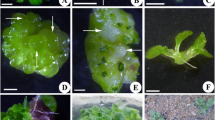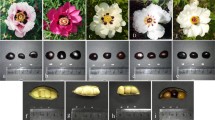Abstract
Tissue culture is preferred for solving the shortcomings of low efficiency of conventional propagation in tree peony (Paeonia sect. Moutan), an economically important woody plant in China with various uses. Paeonia ostii ‘Feng Dan’ is one of the varieties with strong adaptability and high oil productivity. However, in vitro regeneration via organogenesis is hard to obtain. For instance, the indirect organogenesis from callus is a lengthy process, and the direct organogenesis is lacked. This study presents a protocol of direct organogenesis using cotyledon explant for in vitro regeneration of P. ostii ‘Feng Dan’, and includes two pathways. The explants need pretreated in the optimal dedifferentiation induction medium (DIM) [Murashige and Skoog (MS) medium with 2.27 µM thidiazuron (TDZ) + 5.37 µM α-naphthylacetic acid (NAA)] for 10 days, and then the cotyledons without callus induced were transferred to differentiation medium (DM) with 6 subcultures, 90 days in total. The best DM for the frequency of leaf clusters induction (66.67%) was Woody plant medium (WPM) containing 4.04 µM N-(2-chloro-4-pyridyl)-N-phenylurea (CPPU) + 4.54 µM TDZ, and for the frequency of MNs induction (41.67%) was WPM containing 2.02 µM CPPU + 2.27 µM TDZ. For two pathways, mean number of regenerated shoots (≈ 4 shoots per explant), the frequency of root induction (≈ 50%) and the frequency of survival (≈ 40%) were similar. Histological studies confirmed the process of direct organogenesis, and revealed that shoots and MNs were originated from the increased division of meristematic cells under cortical tissue, as well as from actively dividing meristematic cells around the vascular center. Moreover, shoots regenerated through MNs differentiation were originated from the epidermal and subepidermal cells. This study is supplements in the field of in vitro regeneration in tree peony, and is an improvement to current protocols of clonal micropropagation, at the same time facilitating fundamental studies of developmental biology and genetic transformation.
Key message
Plant regeneration through two pathways of direct organogenesis using cotyledon explant was first presented in Paeonia ostii ‘Feng Dan’.










Similar content being viewed by others
Data availability
The data supporting the findings of this study are available with Li Xu and can be made available upon request.
Abbreviations
- BA:
-
6-Benzyladenine
- CPPU:
-
N-(2-chloro-4-pyridyl)-N-phenylurea
- DM:
-
Differentiation medium
- DIM:
-
Dedifferentiation induction medium
- DO:
-
Direct organogenesis
- GA3 :
-
Gibberellin
- IBA:
-
Indole-3-butyric acid
- KT:
-
Kinetin
- MN:
-
Meristematic nodule
- MS:
-
Murashige and Skoog
- NAA:
-
α-Naphthylacetic acid
- PGR:
-
Plant growth regulator
- TDZ:
-
Thidiazuron
- WPM:
-
Woody plant medium
- ZR:
-
Trans-zeatin-riboside
References
Ayala PG, Brugnoli EA, Luna CV, González AM, Pezzutti R, Sansberro PA (2019) Eucalyptus nitens plant regeneration from seedling explants through direct adventitious shoot bud formation. Trees 33(6):1667–1678. https://doi.org/10.1007/s00468-019-01888-5
Bao Z, Zhang YP, Shao CS, Zhang JQ, Liu GF, Bao MZ (2017) A rapid and efficient in vitro shoot regeneration protocol using cotyledons of London plane tree (Platanus acerifolia Willd.). Plant Growth Regul 83(2):245–252. https://doi.org/10.1007/s10725-017-0303-2
Batista D, Ascensão L, Sousa MJ, Pais MS (2000) Adventitious shoot mass production of hop (Humulus lupulus L.) var. Eroica in liquid medium from organogenic nodule cultures. Plant Sci 151(1):47–57. https://doi.org/10.1016/S0168-9452(99)00196-X
Batista D, Fonseca S, Serrazina S, Figueiredo A, Pais MS (2008) Efficient and stable transformation of hop (Humulus lupulus L.) var. Eroica by particle bombardment. Plant Cell Rep 27:1185–1196. https://doi.org/10.1007/s00299-008-0537-6
Cai R, Huang WH, Pan JS, He HL (2002) Developmental morphology and anatomy of direct shoot organogenesis from melon cotyledon. J Wuhan Bot Res 20(5):338–342 (In Chinese)
Carmona-Martin E, Petri C (2020) Adventitious regeneration from mature seed-derived tissues of Prunus cerasifera and Prunus insititia. Sci Hortic 259:108746. https://doi.org/10.1016/j.scienta.2019.108746
Dal Vesco LL, Stefenon VM, Welter LJ, Scherer RF, Guerra MP (2011) Induction and scale-up of Bilbergia zebrina nodule cluster cultures: implications for mass propagation, improvement and conservation. Sci Hortic 128(4):515–522. https://doi.org/10.1016/j.scienta.2011.02.018
Debnath AJ, Gangopadhyay G, Basu D, Sikdar SR (2018) An efficient protocol for in vitro direct shoot organogenesis of Sesamum indicum L. using cotyledon as explant. 3 Biotech 8(3):1–13. https://doi.org/10.1007/s13205-018-1173-7
Du YM, Cheng FY, Zhong Y (2020a) Induction of direct somatic embryogenesis and shoot organogenesis and histological study in tree peony (Paeonia sect. Moutan). Plant Cell Tissue Organ Cult 141(3):557–570. https://doi.org/10.1007/s11240-020-01815-4
Du YM, Zhong Y, Shang HQ, Cheng FY (2020b) Callus induction and differentiation from the filaments of Paeonia ostii ‘Feng Dan.’ Bull Bot Res 40(4):514–522. https://doi.org/10.7525/j.issn.1673-5102.2020.04.005. (In Chinese)
Ferreira S, Batista D, Serrazina S, Pais MS (2009) Morphogenesis induction and organogenic nodule differentiation in Populus euphratica Oliv. leaf explants. Plant Cell Tissue Organ Cult 96(1):35–43. https://doi.org/10.1111/j.1745-4557.2007.00152.x
Fortes AM, Pais MS (2000) Organogenesis from internode-derived nodules of Humulus lupulus var. Nugget (Cannabinaceae): histological studies and changes in the starch content. Am J Bot 87(7):971–979. https://doi.org/10.2307/2656996
Gao Y, Wei SQ, Kuang XM, Qiu YL (2021) In vitro regeneration of cotyledon and histocytological analysis in pepper (Capsicum annuum L.). Front in Plant Sci 25(5):463–470. https://doi.org/10.16605/j.cnki.1007-7847.2021.08.0200
García-Fortea E, Lluch-Ruiz A, Pineda-Chaza BJ, García-Pérez A, Bracho-Gil JP, Plazas M, Gramazio P, Vilanova S, Moreno V, Prohens J (2020) A highly efficient organogenesis protocol based on zeatin riboside for in vitro regeneration of eggplant. BMC Plant Biol 20(1):1–16. https://doi.org/10.1186/s12870-019-2215-y
Geng ZP, Hao N, Du JL, Lu X, Yuan YY, Liu Y, Li JL, Wang MJ, Wang XD, Wang JL (2023) Micropropagation system of Anaphalis hancockii Maxim in vitro and exploration of endogenous metabolome differences coursed by plant growth regulators. Plant Cell Tissue Organ Cult 152(1):81–98. https://doi.org/10.1007/s11240-022-02390-6
Haensch KT (2004) Thidiazuron-induced morphogenetic response in petiole cultures of Pelargonium ×hortorum and Pelargonium × domesticum and its histological analysis. Plant Cell Rep 23(4):211–217. https://doi.org/10.1007/s00299-004-0844-5
Hebert CJ, Touchell DH, Ranney TG, LeBude AV (2010) In vitro shoot regeneration and polyploid induction of Rhododendron ‘Fragrantissimum Improved.’ HortSci 45(5):801–804. https://doi.org/10.21273/HORTSCI.45.5.801
Huang H, Li JC, OuYang KX, Zhao ZH, Li P, Liao BY, Chen XY (2014a) Direct adventitious shoot organogenesis and plant regeneration from cotyledon explants in Neolamarckia cadamba. Plant Biotechnol 31(2):115–121. https://doi.org/10.5511/plantbiotechnology.14.0125a
Huang X, Chen J, Bao Y, Liu L, Jiang H, An X, Dai L, Wang B, Peng D (2014b) Transcript profiling reveals auxin and cytokinin signaling pathways and transcription regulation during in vitro organogenesis of ramie (Boehmeria nivea L. Gaud). Plos One 9(11):e113768. https://doi.org/10.1371/journal.pone.0113768
Kongbangkerd A, Wawrosch C (2003) Improved shoot regeneration from nodules of Charybdis numidica in a temporary immersion system. J Horticult Sci Biotechnol 78(5):650–655. https://doi.org/10.1080/14620316.2003.11511679
McCown BH, Zeldin EL, Pinkalla HA, Dedolph R (1988) Nodule culture: a developmental pathway with high potential for regeneration, automated micropropagation, and plant metabolite production from woody plants. In: Hanover JW, Keathley DE (eds) Genetic manipulation of woody plants. Plenum, New York, pp 149–166
Meng WJ, Cheng ZJ, Sang YL, Zhang MM, Rong XF, Wang ZW, Tang YY, Zhang XS (2017) Type-B Arabidopsis response regulators specify the shoot stem cell niche by dual regulation of WUSCHEL. Plant Cell 29:1357–1372. https://doi.org/10.1105/tpc.16.00640
Moyo M, Finnie JF, Van Staden J (2009) In vitro morphogenesis of organogenic nodules derived from Sclerocarya birrea subsp. caffra leaf explants. Plant Cell Tissue Organ Cult 98(3):273–280. https://doi.org/10.1007/s11240-009-9559-1
Partanen CR (1965) Cytological behaviour of plant tissues in vitro as a reflection of potentialities in vivo. In: White PR, Grove AR (eds) Proceedings of an International Conference on Plant Tissue Culture. McCutchan Publishing Corp., Berkeley, pp 88–100
Piéron S, Belaizi M, Boxus P (1993) Nodule culture, a possible morphogenetic pathway in Cichorium intybus L. propagation. Sci Hortic 53(1–2):1–11
Piéron S, Boxus P, Dekegel D (1998) Histological study of nodule morphogenesis from Cichorium intybus L. leaves cultivated in vitro. In Vitro Cell Dev Biol- Plant 34(2):87–93
Qin L, Cheng FY, Zhong Y, Gao P, Yu HP (2012) Callus development in tree peonies (Paeonia sect. Moutan): Influence of genotype, explant developmental stage and position, and plant growth regulators. Propag Ornam Plants 12(2):117–126
Qosim WA, Purwanto R, Wattimena GA (2013) Indirect organogenesis and histological analysis of Garcinia mangostana L. Asian J Plant Sci 12(6/8):279–284. https://doi.org/10.3923/ajps.2013.279.284
Qosim WA, Purwanto R, Wattimena GA (2015) Comparison of adventitious shoot formation of Garcinia mangostana via embryogenesis and direct organogenesis. Asian J Plant Sci 14(2):78–83. https://doi.org/10.3923/ajps.2015.78.83
Ravindran BM, Rizzo P, Franke K, Fuchs J, D’Auria J (2023) Simple and robust multiple shoot regeneration and root induction cycle from different explants of Hypericum perforatum L. genotypes. Plant Cell Tissue Organ Cult 152(1):1–15. https://doi.org/10.1007/s11240-022-02370-w
Sarkar S, Jha S (2017) Morpho-histological characterization and direct shoot organogenesis in two types of explants from Bacopa monnieri on unsupplemented basal medium. Plant Cell Tissue Organ Cult 130(2):435–441. https://doi.org/10.1007/s11240-017-1231-6
Scherer RF, Garcia GAC, Fraga HP, Vesco LLD, Steinmacher DA, Guerra MP (2013) Nodule cluster cultures and temporary immersion bioreactors as a high performance micropropagation strategy in pineapple (Ananas comosus var. comosus). Sci Hortic 151:38–45. https://doi.org/10.1016/j.scienta.2012.11.027
Traas J (2019) Organogenesis at the shoot apical meristem. Plants 8(1):6. https://doi.org/10.3390/plants8010006
Vernoux T, Brunoud G, Farcot E, Morin V, Van den Daele H, Legrand J, Oliva M, Das P, Larrieu A, Wells D, Guéon Y, Armitage L, Picard F, Guyomarc’h S, Cellier C, Parry G, Koumproglou R, Doonan JH, Estelle M, Godin C, Kepinski S, Bennett M, De Veylder L, Traas J (2011) The auxin signalling network translates dynamic input into robust patterning at the shoot apex. Mol Syst Biol 7(1):508. https://doi.org/10.1038/msb.2011.39
Wang X, Cheng FY, Zhong Y, Wen SS, Li LZM, Huang LZ (2016) Establishment of in vitro rapid propagation system for tree peony (Paeonia ostii). Sci Silvae Sinicae 52:102–110. https://doi.org/10.11707/j.1001-7488.20160512. (In Chinese)
Wen SS, Chen L, Tian RN (2020) Micropropagation of tree peony (Paeonia sect. Moutan): A review. Plant Cell Tissue Organ Cult 141(1):15. https://doi.org/10.1007/s11240-019-01747-8
Xu L, Cheng FY, Zhong Y (2022a) Efficient plant regeneration via meristematic nodule culture in Paeonia ostii ‘Feng Dan.’ Plant Cell Tissue Organ Cult 149(3):599–608. https://doi.org/10.1007/s11240-021-02216-x
Xu L, Cheng FY, Zhong Y (2022b) Histological and cytological study on meristematic nodule induction and shoot organogenesis in Paeonia ostii ‘Feng Dan.’ Plant Cell Tissue Organ Cult 149(3):1–12. https://doi.org/10.1007/s11240-021-02208-x
Yu SY, Du SB, Yuan JH, Hu YH (2016) Fatty acid profile in the seeds and seed tissues of Paeonia L. species as new oil plant resources. Sci Rep 6:26944–26944. https://doi.org/10.1038/srep26944
Zhao D, Xue Y, Shi M, Tao J (2017) Rescue and in vitro culture of herbaceous peony immature embryos by organogenesis. Sci Hortic 217:123–129. https://doi.org/10.1016/j.scienta.2017.01.040
Zhong Y (2011) Induction and Culture of Meristematic Nodules in Paeonia rockii . Bei**g Forestry University, Bei**g In Chinese
Zhu X, Li XQ, Ding WJ, ** SH, Wang Y (2018) Callus induction and plant regeneration from leaves of peony. Hortic Environ Biotechnol 59:575–582. https://doi.org/10.1007/s13580-018-0065-4
Funding
The study was supported by the National Natural Science Foundation of China (32302598), and Natural Science Foundation of Hubei Province of China (2023AFB509).
Author information
Authors and Affiliations
Contributions
CCF and KXL conducted the experiments and written the manuscript. LX designed the experiment and revised the manuscript. ZJD, SMD, JTL and JLM assisted in guiding the experiments. All authors read and approved the final manuscript.
Corresponding author
Ethics declarations
Ethical approval
This article does not contain any studies with human participants or animals performed by any of the authors.
Conflict of interest
The authors declare that they have no conflict of interest.
Additional information
Communicated by Ranjith Pathirana
Publisher's Note
Springer Nature remains neutral with regard to jurisdictional claims in published maps and institutional affiliations.
Rights and permissions
Springer Nature or its licensor (e.g. a society or other partner) holds exclusive rights to this article under a publishing agreement with the author(s) or other rightsholder(s); author self-archiving of the accepted manuscript version of this article is solely governed by the terms of such publishing agreement and applicable law.
About this article
Cite this article
Fan, C., Li, K., Xu, L. et al. Plant regeneration through two pathways of direct organogenesis in Paeonia ostii ‘Feng Dan’. Plant Cell Tiss Organ Cult 158, 7 (2024). https://doi.org/10.1007/s11240-024-02793-7
Received:
Accepted:
Published:
DOI: https://doi.org/10.1007/s11240-024-02793-7




